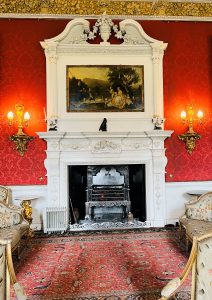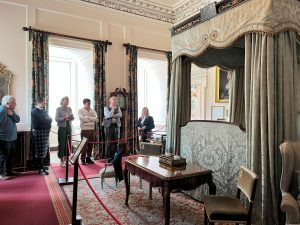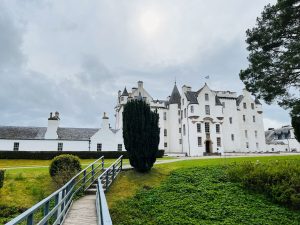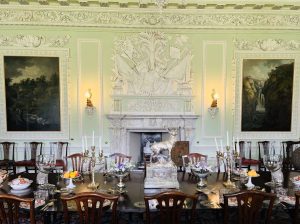Interpreting historic houses at Blair Atholl Castle, Perthshire, Scotland
Our guest poster today is Dr Helen McCormack, Reader in Art and Design History at The Glasgow School of Art. Helen has published widely on the domestic interior as a site of scientific discovery and social networking, especially in her 2018 book William Hunter and his Eighteenth-Century Cultural Worlds (London: Routledge). –ANR

Fireplace detail in the Drawing Room at Blair Atholl Castle, Perthshire, Scotland. Johann Zoffany’s The Family of the 3rd Duke of Atholl, 1765-67, hangs over the fireplace. Photo courtesy of Helen McCormack
The Scottish Graduate School for Arts and Humanities (SGSAH) is the central organisation for funding and supporting postgraduate education in Scotland. Each year, the SGSAH arrange training and networking events across the country for doctoral and postgraduate research students. As part of these events, the SGSAH Museums and Cultural Studies Catalyst Panel, proposed one such event for students centred around the theme of historic houses. In a recent volume on politics and the country house, Dana Arnold asked, ‘How do we narrate or interrogate the country house as a phenomenon …? In common with all architecture, it is at once a lived and spatial experience, an aesthetic object, and an economic engine’. In response to her provocation, Professor Ian Baxter (Heriot Watt University) and I organised a day’s event to consider a range of questions around interpretations of historic house interiors, spaces and environments. Blair Atholl Castle, the ancient estate of the Dukes of Atholl, kindly hosted the event on April 28, 2025. A timetable of the day’s events, including links and suggested readings, is available here.
The morning session involved an exploration of the interior space, with a focus on the interpretative and communicative aspects of interiors, incorporating furnishings (wallpapers, furniture, textiles, decorative objects), alongside formal collections of fine art. Methodological approaches covered in the session included visual and material culture studies, and the meticulous examination of related objects and documentary archives. These included aspects of household repositories and inventories, family records, local and national archives in official record offices, all of which contribute to accounts that enlarge and diversify meanings attached to interior domestic objects.
In the afternoon, students and speakers wandered outside the castle to consider interrelated aspects of the immediate designed landscape, representing ‘landedness’ as a form of power associated with landownership. Many of Scotland’s historic houses are located within sites of antiquity and reflect changing archaeological and agricultural attitudes to the natural environment. During this session, led by Christopher Dingwall, participants considered how architects, artists, designers, and writers have responded to these cultivated and wild landscapes.
Speakers on the day included archivist to the Atholl estates, Keren Guthrie, who explained the extent of the archives, which remain in the family and are kept in the castle’s improved archival storage rooms. Dr Craig Thomas, Assistant Archivist at Buccleuch Living Heritage Trust, who looks after the records of the Dukes of Buccleuch in Scotland, Sarah Roller, Director of Policy at Historic Houses Association, and Glasgow School of Art PhD candidate, Haitang Zhang, who presented a paper on ‘house museums as primary research’ as part of her doctoral project, entitled ‘A museum of intimate space: augmented and virtual reality in speculative displays’. I delivered a paper based on my recently-published edited volume, co-edited with Jennifer Gray and Anne Nellis Richter, Reassembling the Social Interior: historical spaces from contemporary viewpoints (Manchester University Press, 2025), and Ian Baxter focused on historic houses and their ‘experiential and career contexts’. All the while, on the hour, Blair Atholl’s resident piper played a series of reels and laments just outside the main entrance, so that the ‘skirl of the pipes’ punctuated our conversations taking place in the castle’s great ball room.
Present-day concerns over land, property, and the housing crisis, often make it difficult to imagine what historic houses, spaces and environments might tell us about the future. As the focus of the event centred on lived experiences of historical houses, spaces and environments (not to mention homes), students were encouraged to consider embodied and subjective approaches that foreground tangible encounters. Current fascination with historic houses, spaces and environments, as demonstrated in television shows such as A House through Time, re-enactments of historical spaces in Outlander, for example, augmented reality and digital reconstructions, and the continuing attraction of visits to country houses, represent the enduring appeal of historic houses through and beyond academic enquiry. The success of the event also demonstrated a lively interest among graduate students to engage with historic interiors, spaces and environments, to generate new and exciting research knowledge and insights.


